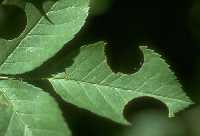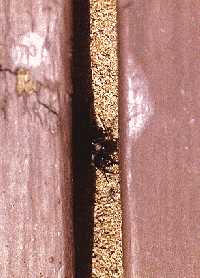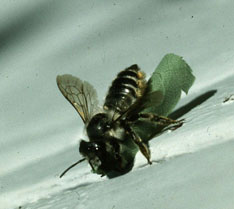by W.S. Cranshaw* (12/12)
Quick Facts…
 |
Figure 1: Leafcutter bee (and crab spider) visiting flower. |
 |
Figure 2: Leafcutter bee injury. |
- Leafcutter bees are native bees, important as pollinators.
- Leafcutter bees are not aggressive and have a mild sting that is used only when they are handled.
- Leafcutter bees cut the leaves of plants. The cut leaf fragments are used to form nest cells.
- Leafcutter bees nest in soft, rotted wood or in the stems of large, pithy plants, such as roses.
Leafcutter bees are important native insects of the western United States. They use cut leaf fragments to construct their nest cells. They often are essential pollinators of wild plants. Some leafcutter bees are even semidomesticated to help produce alfalfa seed. However, their habit of leaf cutting, as well as their nesting in soft wood or plant stems, often attracts attention and concern.
Life History and Habits
Most common leafcutter bees (Megachile spp.) are approximately the size of the common honeybee, although they are somewhat darker with light bands on the abdomen. They also have different habits. Leafcutter bees are not aggressive and sting only when handled. Their sting is very mild, much less painful than that of honeybees or yellowjacket wasps.
Leafcutter bees are solitary bees, meaning that they don’t produce colonies as do social insects (honeybees, yellowjackets, ants, etc.). Instead, individual female leafcutter bees do all the work of rearing. This includes digging out nesting areas, creating nest cells and providing their young with food. Adult females may live up to two months and lay some 35 to 40 eggs during this time.
Leafcutter bees nest in soft, rotted wood; thick-stemmed, pithy plants (e.g., rose); and in similar materials that the bees can easily cut through and excavate. Nest tunnels may extend several inches deep and coarse sawdust may be deposited at the entrance. This sometimes causes confusion with other wood nesting insects such as carpenter ants. However, leafcutter bees restrict their tunneling to soft, rotted wood and do not cause damage to homes or other wooden structures.
 |
Figure 3: Leafcutter bee nesting on porch, with sawdust. |
There also are concerns about leafcutter bee nesting in rose canes, excavating the pith of pruned canes. Leafcutter bees sometimes nest in the largest diameter rose canes but cause little damage because they restrict tunneling to the pith and rarely girdle cambium. Furthermore, other insects, including various hunting wasps (Pemphredon species) and small carpenter bees more commonly tunnel and nest in rose canes.
After the nest is made, the bees collect fragments of leaves to construct individual nest cells. The bees cut leaves in a distinctive manner, making a smooth semicircular cut about 3/4 inch in diameter from the edge of leaves. Although they cut many types of leaves, leafcutter bees prefer certain types, notably rose, green ash, lilac and Virginia creeper. This injury often is only a minor curiosity. However, where leafcutter bees are abundant and concentrate on cultivated plantings, the removal of leaf tissues can be damaging. Serious damage most often occurs in isolated rural plantings.
Leafcutter bees do not eat the cut pieces of leaves that they remove. Instead, they carry them back to the nest and use them to fashion nest cells within the previously constructed tunnels. Then they provision each leaf-lined cell with a mixture of nectar and pollen. The female lays an egg and seals the cell, producing a finished nest cell that somewhat resembles a cigar butt. A series of closely packed cells are produced in sequence. A finished nest tunnel may contain a dozen or more cells forming a tube 4 to 8 inches long. The young bees develop and remain within the cells, emerging the next season.

Figure 4: Cells of leaf-cutter bee, packed with pollen, exposed from a hollow stemmed weed. |
There are a great many parasites that act as important natural enemies of leafcutter bees. As a result, leaf cutting activity may vary widely from year to year. Parasitic bees and wasps, velvet ants and certain blister beetles are among the most important enemies of leafcutter bees and other solitary bees.
At least one species of leafcutter bee is cultivated for agricultural use in Colorado. Megachile rotundata is used to pollinate alfalfa grown for seed, a function that it does far more efficiently than honeybees. These leafcutter bees are provided with predrilled “bee boards” that they use for nest construction. At the end of the season, the nest cells with developing bees are collected and carefully stored, to be released the subsequent season when alfalfa blooms.
Control
Insecticides are ineffective for preventing leaf cutting. The only known control of leaf injuries is to cover susceptible plants with cheesecloth or other loose netting during periods when leafcutter bees are most active.
Numbers of leafcutter bees in an area can be reduced if breeding sites are eliminated, although these might be difficult to detect. Look for rotting boards with sawdust pushed out of excavated tunnels or thick stemmed plants with hollowed openings.

Figure 5: Leafcutter bee carrying leaf fragment. |
To prevent leafcutter bees from tunneling into rose canes, seal exposed pith as canes are pruned. This can be easily achieved by placing a thumb tack, bit of sealing wax or white glue on the opening.
1Colorado State University Extension entomologist and professor, bioagricultural sciences and pest management. 12/97. Revised 12/12.
Reviewed 11/06.
Colorado State University, U.S. Department of Agriculture, and Colorado counties cooperating. Extension programs are available to all without discrimination. No endorsement of products mentioned is intended nor is criticism implied of products not mentioned.
Go to top of this page.





